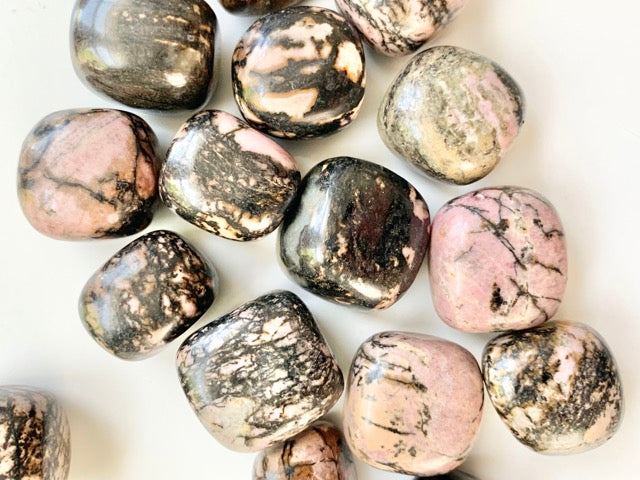
Rhodonite: Exploring the Geological and Mineralogical Properties
Share
Rhodonite is a mineral (Chemical formula CaMn3Mn[Si5O15]) named in 1819 by Christoph Freidrich Jasche. The name rhodonite comes from the Greek “rhodo” meaning rose, referring to its characteristic pink to red color. Rhodonite deposits, however, can range in color from pink to brown to nearly purplish red, and surface oxidation can cause the surface of the stone to look nearly brown.

Rhodonite Towers showcasing a variety of colors and patterns
It is primarily composed of manganese silicate and typically is found with dark brown, gray, or black streaks of black manganese oxides patterning the stone as dendrites, or filling fractures, or even as part of the matrix. It typically occurs in metamorphic rocks, and is often found in association with other minerals such as pyrite, quartz, and garnet.

Chemical formula: CaMn3Mn[Si5O15]
Rhodonite is a relatively hard mineral, with a Mohs hardness of 5.5 to 6.5. It has a vitreous to pearly luster, and a translucent to opaque appearance.
Rhodonite Crystal Structure and Habit
Rhodonite is most often found in granular masses with rather indistinguishable crystals. It can also form tabular crystals, but that is far less common.

Raw Rhodonite Granular Mass
Rhodonite has a crystal structure that belongs to the triclinic system, which means that it has three axes of unequal length that intersect at oblique angles. At the atomic level, rhodonite is composed of interconnected chains of manganese, silicon, and oxygen atoms, which are arranged in a specific pattern known as a pyroxene chain.
The triclinic crystal system is one of the seven crystal systems in which crystalline solids can be classified based on their symmetry. In the triclinic system, the crystal lattice is characterized by three axes of unequal length, which intersect at oblique angles. The triclinic system is the least symmetrical of all the crystal systems. Because of their lack of symmetry, triclinic crystals can exhibit a wide range of shapes and habits, and their properties can vary depending on the orientation of their crystal lattice.
Rhodonite has a nearly perfect cleavage in one direction, which means that it can be easily split along a specific plane to form smooth surfaces. The cleavage plane in rhodonite is parallel to the crystal face. When rhodonite is cleaved along this plane, it produces smooth, flat surfaces with a pearly to vitreous luster.
The perfect cleavage in rhodonite is a result of the crystal structure of the mineral. Rhodonite has a pyroxene crystal structure, which consists of chains of linked SiO4 tetrahedra. The cleavage plane in rhodonite is perpendicular to these chains, which makes it easier for the mineral to break along this plane.

The perfect cleavage in rhodonite makes it a popular material for carving and polishing into gemstones and decorative objects.
Rhodonite Varieties
There are a few different varieties of rhodonite, each of which is characterized by specific properties or features:
Fowlerite
This rare variety of rhodonite is zinc rich and contains small amounts of lead, and is typically found in association with other lead and zinc minerals. It has a distinctive brownish-red color, and is valued as a collector's item.
Bustamite
This material is between rhodonite and wollastonite.This variety of rhodonite contains a significant amount of calcium substituting for manganese, which gives it a reddish-brown to brown color, with the color typically being paler than rhodonite. Its color will fade over time if exposed to direct sunlight.
Where is rhodonite found?
Rhodonite is found in many locations around the world, including Australia, Brazil, Japan, Italy, Romania, Mexico, Canada (British Columbia), Peru, Russia, and the United States. In 1979 it was declared the state gem of Massachusetts due to the productive mine found in that state. Rhodonite has also been found in other states such as New Jersey, North Carolina, and Colorado.
Rhodochrosite vs Rhodonite
Rhodochrosite is a pink to red mineral that contains primarily manganese and carbonates. It has a hardness of 3.5 to 4 on the Mohs scale and a specific gravity of 3.5 to 3.7. Rhodochrosite is typically found in hydrothermal veins and is often used as a semi-precious gemstone.
One of the key differences between rhodonite and rhodochrosite is their chemical composition. While both minerals contain manganese, rhodonite contains additional elements such as iron, magnesium, and calcium, while rhodochrosite contains carbonates. Another difference is their hardness on the Mohs scale, with rhodonite being harder than rhodochrosite. Finally, rhodonite is typically found in metamorphic rocks, while rhodochrosite is typically found in hydrothermal veins.
Despite these differences, both rhodonite and rhodochrosite are valued for their pink to red coloration and are used in various applications such as jewelry, decorative carvings, and as mineral specimens for collectors.
Rhodonite History and Uses
Rhodonite is commonly found in the Ural Mountains region of Russia. It’s thought that the pink stones used as talismans for babies called “orlets,” in 18th-century Ural Mountain villages near Sidelnikovo, Russia were rhodonite. It was thought the eagles–symbols of strength and courage– brought the stones to their own nests, and by placing the stones next to the babies, it would encourage the same traits. These orlets were also given to newlywed couples for protection and fertility.

Rhodonite became very popular and sought after in Russia. In fact, the sarcophogus of Russian Emperesss Maria Alexandrovna (wife of Alexander II) was carved out of the largest solid chunk of rhodonite in the world! This can be seen at Peter and Paul Cathedral in St. Petersburg where she is entombed next to her husband.
Today, rhodonite is mainly used for decorative carvings, tumbles, free forms, and lapidary purposes. Rhodonite is considered one of the more difficult stones to cut and facet, so it’s more likely to be found as cabochons or beads. High quality crystal specimens are highly sought after by mineral collectors and can carry a hefty price tag.

In addition to its aesthetic uses, rhodonite is also valued for its physical and metaphysical properties. Some people believe that rhodonite has a calming and balancing effect on emotions and can help reduce anxiety. It is also said to help promote self-confidence and self-esteem, generating more self love. Some even refer to it as the stone of love.
Rhodonite is a beautiful and unique mineral that holds many benefits and uses. Whether you're drawn to its aesthetic appeal or its healing properties, it's clear that rhodonite is a versatile stone with much to offer. So, if you're interested in exploring the world of minerals and gemstones, consider adding rhodonite to your collection. With its striking colors and powerful energy, it's sure to be a valuable addition.
Rhodonite is a complex, intriguing, and absolutely stunning stone we that cannot get enough of around here.
